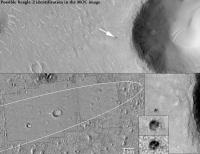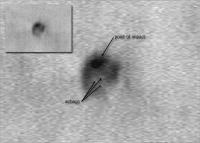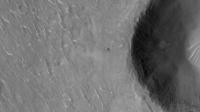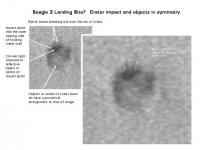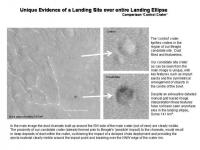Printable Version of Topic
Click here to view this topic in its original format
Unmanned Spaceflight.com _ Mars Express & Beagle 2 _ Wreckage Of Beagle 2 Found?
Posted by: imran Dec 20 2005, 01:07 AM
http://www.timesonline.co.uk/article/0,,2-1943819,00.html
Talk about being unlucky assuming this is confirmed.
Posted by: ermar Dec 20 2005, 01:40 AM
Unlucky? Seems pretty lucky for Pilinger if it checks out...
http://mars.jpl.nasa.gov/mgs/msss/camera/images/jan_01_beagle2_pt2/index.html
That link seems to cover the Beagle landing area (albeit some time before the landing), but I'm not quite sure which crater is the suspect one or what the relevant pictures are...
(could be feature discussed in http://www.msss.com/mars_images/moc/2004/08/31/)?
Posted by: lyford Dec 20 2005, 02:04 AM
Dr. Pillinger, http://news.bbc.co.uk/2/hi/science/nature/3354271.stm
Dr. Pillinger, http://www.timesonline.co.uk/article/0,,2-1943819,00.html:
I shan't be going to Vegas with the Good Doctor. (Though I hope he has been saving his good luck for his fight with http://news.bbc.co.uk/2/hi/science/nature/4671941.stm)
Posted by: jamescanvin Dec 20 2005, 03:00 AM
I didn't see one on the page linked by imram but the http://news.bbc.co.uk/1/hi/sci/tech/4542174.stm has a picture.
I hope they have a 'before' shot, else I'm going to be more than a little skeptical.
James
Posted by: odave Dec 20 2005, 03:31 AM
Yep, shades of the false ID of MPL's remains earlier this year. If anything, it gives MRO one place to look in the haystack of the ellipse.
Posted by: dilo Dec 20 2005, 05:15 AM
I hope they have a 'before' shot, else I'm going to be more than a little skeptical.
James
The BBC image show exactly the same feature http://www.msss.com/mars_images/moc/2004/08/31 in ermar post, but negative/contrast-enhanced version. Below I made a resume poster of identification...
If identification is correct, there is a commonality between Opportunity and Beagle: both landed inside craters of similar sizes...!
Howewer, looking to the high-res crater images, I'm very skeptical too. A promising elevated structure visible in original 1.5 m/pixel MOC view (lower inset) seems not visible in the cPROTO obtained in April 2004 (upper inset), obtained under similar illumination condition; the presumed "airbag" feature in the crater center doesn't convince me...
Posted by: deglr6328 Dec 20 2005, 07:04 AM
Ohh yes! If I squint hard enough I can just make it out and if you squint juuuust a bit harder you can make out some channel like forms which appear to be in the shape of canals that..... ![]() Seriously, I think this is silly, we're nearly looking at individual pixels here people, just above the noise floor and we're talking about a humungous haystack. They're two parallel lines, wouldn't sand dunes be a slightly more prosaic cause?
Seriously, I think this is silly, we're nearly looking at individual pixels here people, just above the noise floor and we're talking about a humungous haystack. They're two parallel lines, wouldn't sand dunes be a slightly more prosaic cause?
Posted by: djellison Dec 20 2005, 08:33 AM
Well - to be fair, Oppy didnt land in a crater, it rolled into one
I just saw CP on BBC Breakfast News, and he was fairly cautious that
Unless B2 broke up high in the atmosphere and burnt up, there should be SOMETHING on the ground. A new impact crater, or a parachute, or a parachute and some airbags etc etc depending on how far the whole thing got. Given how easily the MER chutes were spotted - SOMETHING should be visible, and this is as good a candidate as anything, so it gives a specific target for HIRISE, and given the HIRISE data flow, I'm going to be hooked on the data when it arrives
Doug
Posted by: djellison Dec 20 2005, 09:38 AM
Just had a thought - if the impact into the side of the crater wall was enough to lunch the spacecraft, then how did the spacecraft trigger the pyros to jettison the three airbags? They couldnt be that far apart yet not seperated could they? WHo knows, hopefully MRO will tell us what's really in that little crater in 12 months time or so.
Doug
Posted by: Richard Trigaux Dec 20 2005, 09:45 AM
Hmmmm...
So there was no error or malfunction of the lander.
But it seems that landing into hollowed places is not uncommon. Imagine it had landed a bit more to the right, in the larger crater... rolling all along the slope, to end up bogged into a dune in the bottom.
This is, I think, a lesson to retain: we cannot design landers able to land only into ideal flat places. The landers must be able to land into harsh places, including craters and slopes.
Posted by: djellison Dec 20 2005, 10:05 AM
ORRrr....
Design them with the ability to navigate themselves to locally safe places to land during terminal descent.
Doug
Posted by: jamescanvin Dec 20 2005, 10:38 AM
Ah, yes, sorry didn't notice ermar's second link (it's been a long day)
Thanks for the poster, very useful.
Looks like a crater to me.. maybe with some kind of, err, abyss! It's hard to tell for sure.
James
Posted by: djellison Dec 20 2005, 10:58 AM
I went and found the orig MSSS image, got the IMG, NASA-Viewed it, did a trick a read that Phil uses by essentially subtracting from the whole image a vertical average of every column of pixels ( to subtract some of the streaking - I duplicated the image, resized to one pixel high, resized to the full size, inverted and put at 50%...ish) - then enlarged by 50% with simply nearest neighbour interpolation to not infer anything that isnt there, and then did the same trick of Phil's again to get rid of a little more noise, and came up with this.
Doug
Posted by: edstrick Dec 20 2005, 11:03 AM
It's a good candidate for the remains. Better candidate than that smudge in the polar layered terrain they suspected was Polar Lander.
Posted by: djellison Dec 20 2005, 11:47 AM
Data from http://www.msss.com/moc_gallery/r16_r21/images/R16/R1602082.html Courtesy NASA/JPL/MSSS - go play 'spot the chute' - I cant find it, then again, I couldnt find the Pathfinder one either.
The lables are my best guess from the description on the BBC News website
Doug
Posted by: Decepticon Dec 20 2005, 01:29 PM
I bet it landed OK but did not function due to technical difficulties.
You heard it here first People!
** Ducks at tomatoes!** ![]()
Posted by: Phil Stooke Dec 20 2005, 01:38 PM
Nice image processing, Doug - or 'the other Phil' as I think you should now be called.
I have no confidence in this finding, alas. In particular, as Doug's enlarged image of the crater shows, the three-dot pattern suggested to be the airbags could be matched to a thousand locations in that MOC image alone. I thought the MPL location was much more solid, and that turned out to be a mistake.
Phil
Posted by: Bjorn Jonsson Dec 20 2005, 02:35 PM
Doug
This looks like a regular crater to me with no 'artifacts' at all. The image at the BBC website looked a little more convincing - until I saw the annotated version ;-). I doubt even MRO is going to determine exactly where Beagle landed, assuming it did land in roughly one piece.
Posted by: RNeuhaus Dec 20 2005, 03:16 PM
So there was no error or malfunction of the lander.
But it seems that landing into hollowed places is not uncommon. Imagine it had landed a bit more to the right, in the larger crater... rolling all along the slope, to end up bogged into a dune in the bottom.
This is, I think, a lesson to retain: we cannot design landers able to land only into ideal flat places. The landers must be able to land into harsh places, including craters and slopes.
I agree it. The landing guessing cost is rather too high so it is rather convenient to invest more the intelligent landing technology in order to minimize the misfortune. Consequently the overall will lead a lower mission cost.
Long time ago, in the Skycrane topic I have discussed about the importance to incorporate a sophisticated software to analyze the landing image and mark a CROSS or zone for the best landing place.
That is a new and the next technology evolution. The aim for all next spacecraft landing in any solar system must have incorporated the landing software. Up to now, all spacecraft has landed by the luck. None of them have analyzed the surface and select the place before landing. Some probe very lucky (Huygens) and some very bad luck (Beagle2).
Rodolfo
Posted by: JRehling Dec 20 2005, 05:25 PM
Phil
I mightily agree. I would bet "the field" against this site being the actual site. MRO can show us the closeup when it arrives.
The story of the ongoing rhetorical huffing and puffing is rather sad. Before the arrival, it was confidence bordering on arrogance, which wouldn't have been a problem if it had been Pillinger vs. Mars instead of Pillinger vs. NASA Yanks. Now it's all too predictable that he would grasp at an unlikely detection and argue that it was the right design but just bad luck. I think the "hole in one" idea is a subliminal transfer from Opportunity. My bet is that MRO will show Beagle 2 sitting crashed on open ground, and then Pillinger won't have anything but the unexpectedly thin atmosphere to scapegoat and avoid concluding that his design was wrong.
Posted by: Richard Trigaux Dec 20 2005, 05:33 PM
Long time ago, in the Skycrane topic I have discussed about the importance to incorporate a sophisticated software to analyze the landing image and mark a CROSS or zone for the best landing place.
That is a new and the next technology evolution. The aim for all next spacecraft landing in any solar system must have incorporated the landing software. Up to now, all spacecraft has landed by the luck. None of them have analyzed the surface and select the place before landing. Some probe very lucky (Huygens) and some very bad luck (Beagle2).
Rodolfo
Newest image analysis could allow today for real-time 3D analysis of the terrain, provided there is a camera aboard (two wiews of the same spot make a stereo view, as a probe seldom lands vertically). This is done for most modern homing missiles which go much faster than a probe...
Posted by: tedstryk Dec 20 2005, 06:36 PM
I am not buying it, although I will suspend judgment until I have seen high resolution images of the rest of the crater. It is hard to believe that there are no marks in the crater (At least the part seen, and yet it bounced around in there hard enough to destroy it and then propel it out of the crater, after which, rather than bouncing, the little Beagle made this 20-30 meter splat mark. I buy that this could be the Beagle, but I would content, unless more coverage of that crater proves otherwise, that if it is the Beagle, it came hurtling out of the sky and splattered there, fortunately being near a crater, providing a great excuse. MRO's resolution and multispectral capabilities can resolve both ends of this, scouring for other marks and seeing if there are color variations that indicate that this is anything but a small, young, natural crater.
Posted by: Sunspot Dec 20 2005, 06:47 PM
I dont think you've read the news report correctly... he's not suggesting Beagle 2 created the crater when hitting the surface....... but landed in it.
http://www.beagle2.com/index.htm The Beagle website has a VERY thorough explanation of the news as well as a few bits of information not in the news reports.
Posted by: volcanopele Dec 20 2005, 08:31 PM
I hope they have a 'before' shot, else I'm going to be more than a little skeptical.
James
I'm with you. Without a before picture, all I see are a few dark and bright spots in a small crater, on the slope of a much larger crater. If there was a before picture that didn't show those, I would be much more convinced. That is one of the beauties of the MOC images of the MER landing sites. Before and after photos make it clear where the rovers landed, where they are, and where they have been (from the tracks which change from image to image).
Posted by: djellison Dec 20 2005, 09:10 PM
I agree - it's not much and certainly far from conclusive..
But, given fairly comprehensive MOC coverage of the landing ellipse, it's basically all there is. It's not much, I know, but it's arguably the only target worthy of HIRISE's attention.
Doug
Posted by: RNeuhaus Dec 20 2005, 09:24 PM
I was not aware of Beagle 2 mission. After reading Beagle 2's pages and I realized that its landing design was not redundant. It only used the aerobaking during the initial landing, used one kind of parachute and then...air bags.
It is too dangerous since after the parachute, there is no means to break if the probe landing speed is too fast. By incorporating the rockets propulsion as the last resource since it can adjust the landing speed before the probe touch down on the land.
By that time, no one knows by sure about the atmosphere density and others ephemeral Martian parameters and the Beagle 2 landed with a static landing system by aerobraking, parachute and air bags. I seems that it is one of the greatest errors.
I concur Volcanopele about the importance to have good detail pictures of landing place before any planned landing. This will help to find fast the landing site by just comparing among the images by the computer.
Posted by: BruceMoomaw Dec 20 2005, 09:58 PM
This was always regarded by engineers before the landing as one of the most dangerous aspects of the Beagle design. The assumption (or hope) was that, being so much lighter than Pathfinder, a parachute and airbags alone without a last-second solid retromotor would be adequate -- but this is one of the most likely possible causes of the failure, given the fact that they had some problems with the airbags even during ground testing and had to fall back on JPL for emergency assistance in retesting them.
Posted by: AstronomíaOnline.com Dec 21 2005, 03:11 AM
The Search For Beagle 2
http://www.beagle2.com
Technical Contributors: Stuart Hurst, Colin Pillinger, Jim Clemmet, Lutz Richter, Dave Northey, Lester Waugh.
Image Analysis by Guy Rennie.
Mars Images Courtesy Mike Malin.
Posted by: tedstryk Dec 21 2005, 03:56 AM
http://www.beagle2.com/index.htm The Beagle website has a VERY thorough explanation of the news as well as a few bits of information not in the news reports.
I am not saying it made the big crater in the frame. But I am pointing out the size of what is supposedly the beagle...That had to splatter hard, which meant it had to be going really, really fast.
Posted by: ljk4-1 Dec 21 2005, 04:59 AM
Most ironic, if Beagle 2 landed in a small crater just as Opportunity did.
Posted by: BruceMoomaw Dec 21 2005, 08:30 AM
Given how close MER-A (I refuse to use that cornball name "Spirit") came to disaster because of the unexpectedly low density of Mars' upper atmosphere -- even after its hasty last-minute reprogramming to open its parachute earlier, it came within 3 seconds of opening the chute too late to avoid a crash -- I think this has an excellent chance of being the fatal flaw in Beagle: it just came down too damned fast due to the lower than predicted Martian air density, and kaplooey. We'll never know whether some additional flaw also existed that would have done it in anyway, given the flaws that the failure board found to be riddling its design -- but the air density problem by itself would have been enough, and is very likely to have happened.
I am only now coming to realize how hard it actually is to land on Mars because of its peculiar halfway nature. As Ed Strick (and Rob Manning) say, it's very hard to utilize either purely aerodynamic braking or purely rocket braking to land on it, and Mars' thin air density has a height profile such that it's difficult even to combine the two effectively enough to get the braking job done in time. We may actually have been very lucky up to now to pull off as many successful Mars landings as we have -- most of the previous failures (Mars 2, 3 and 7; Polar Lander) were due to unconnected technical problems, but Mars' atmosphere alone may seriously endanger landers, and may conceivably have done in both Mars 6 and Beagle as well as almost killing MER-A. And the bigger the lander, the more serious the problem rapidly becomes.
Posted by: Sunspot Dec 21 2005, 10:29 AM
If i'm remembering this correctly, and it was a long time ago at the first post landing press briefing, didnt one of the landing team say that the parachute deployed about 1 mile below the predicted altitude?
Posted by: djellison Dec 21 2005, 10:54 AM
Unfortunately, only the data sets for EDL are out, and not the derrived onces such as altitude, speed, temp, pressure etc etc. Once they are, I'll put some graphs together for all three ( MPF, MERA, MERB ) - and see what story they tell. Infact, I dont know if they actually will be out - I'd have thought if they were going to be, they would have been by now.
Doug
Posted by: Nix Dec 21 2005, 04:19 PM
Is it me or is there a radial pattern of dark streaks around the dark 'impact' spot? I see about 5 streaks -maybe indicative of debris or dust-removal by the impact?
They don't seem to be related to the little crater itself.
Nico
Posted by: Nix Dec 21 2005, 04:34 PM
Also, every similar crater in the area doesn't show a spot that dark with such clear contours, within the shadow area. Could be dust buildup..maybe...but I think they're right on this.
Posted by: mcaplinger Dec 21 2005, 04:40 PM
I believe that Viking had pretty good margins against density variations. The best way to get margin is to have more propellant available. Much of the "difficulty" of landing on Mars comes from using a landing system like MPF/MER, which has very, very thin margins because the RAD firings happen so late in the descent and don't provide all that much delta-v. To a certain extent, the MPL/PHX system is tight because of propellant mass constraints, but I don't think those margins are nearly as tight as MER's.
Is there some publically-accessible writeup about the "near-disaster" on MER? I've only heard these rumors.
Posted by: Sunspot Dec 21 2005, 06:14 PM
They don't seem to be related to the little crater itself.
Nico
Thats a feature the Beagle team have noted too..... see the Beagle website www.beagle2.com In the closeup image (slide 7) you can see a few "fingers" of darker material protruding from the top of the crater - which has been interpreted as possible ejecta caused by Beagle 2 hiting the crater.
Posted by: Nix Dec 21 2005, 08:29 PM
Thanks Sunspot. ![]()
Nico
Posted by: ugordan Dec 21 2005, 09:38 PM
If this crater indeed turns out to be Beagle's resting place, it would really be a mindblowing case of bad luck... Just seeing how sparse the crater density is in the area and it managed to drop right into one.
Opportunity was said to have struck a whole in one, but this is beyond words. ![]()
At least Mr. Pillinger will be able to take some comfort in the fact Beagle 2 succeeded in reaching the ground more or less intact. But fate has, once again, turned her back on him...
Posted by: mcaplinger Dec 21 2005, 09:58 PM
Well put. It also seems to me that many of the "features" are aligned with the downtrack direction of the image and are thus likely to be residual pixel-to-pixel variations.
People can believe what they want, but I think there is an element of wishful thinking in the Beagle team's claim. MSSS took these images in 2004 and examined them closely. The MSSS position is made pretty clear on the page at http://www.msss.com/mars_images/moc/2004/08/31/ -- "no incontrovertible evidence of the Beagle 2 lander was found within the areas imaged by MOC". To make claims that the Beagle landing system was without flaws and failed only due to highly-improbable terrain factors would, it seems to me, require evidence far less equivocal than this.
It seems a bit odd that it took them over a year to "painstakingly study" this image and come to their conclusion.
Posted by: Sunspot Dec 21 2005, 10:35 PM
It was originaly suspected that the crater visible in these images might have been produced by Beagle 2 impacting the surface at very high speed, not that Beagle 2 may have come down IN the pre-existing crater itself. The former scenario is the one discounted by MSSS.
Posted by: mcaplinger Dec 21 2005, 10:44 PM
The crater was clearly too large to have been created by the Beagle impact, as noted on the MSSS page. I think we would have been open to the possibility that Beagle was inside a pre-existing crater, had the image supported that interpretation. There are many craters in the search area that have dark sand in them; it's not at all unusual.
This is, of course, not an official MSSS statement, but I don't think anyone here would argue with it.
Posted by: Sunspot Dec 21 2005, 10:49 PM
Take a look at slide 5 on the Beagle website:
Also......will MRO REALLY be able to resolve this for what it really is?
Posted by: RNeuhaus Dec 21 2005, 10:53 PM
I am still not convinced about the Beagle 2's landing position. My questions are:
It was redited after a more toughts and research.
Dec 19 8:11:00 Seperation from Mars Express. Beagle 2 will orbit around Mars for almost 6 days.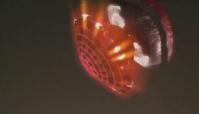
Dec 25 2:47:48 Desaceleration. Highest temperature is 1,700 Centigrades at 120 km heigth.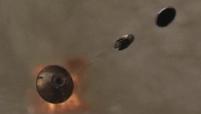
Dec 25 2:51:02 Open parachute at the height of 2,6 km of Mars surface.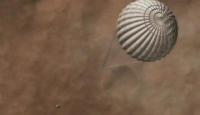
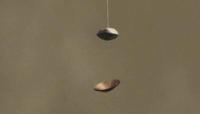
Dec 25 2:51:20 Turn on the altimeter and it checks the altimeter 10 times per seconds.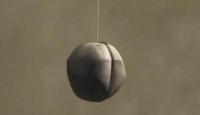
Dec 25 2:51:45 Inflate the air bags at 275 meters of altitude. The altimeter detects the presence of surface and activate the inflation of airbags.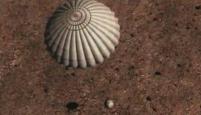
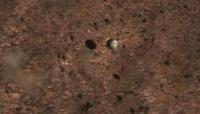
Dec 25 2:52:00 First bounce (15 seconds) at 58 km/sec.
Sixth bounce (10 seconds)
Tenth bounce (6 seconds)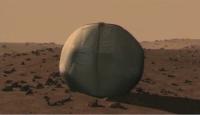
Dec 25 2:54:00 rest on Isidis Plantia after 12 bounces.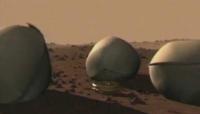
-Separation of airbags from Beagle 2 which was inside of a big Airbag.
-The three airbags were fired away from Beagle 2.
Dec 25 5:30:00 Try to contact with Mars Odyssey. 
1) The picture shows FOUR dark spots. They aren't of the same size. The Right and down are of similar sizes, the Up is bigger and the Left is the biggest. Different sizes.... ![]() Let suppose there is 3 airbags which are of white color and the fourth might be of lander, heatshield or backcover. Then let suppose that the heatshield or backcover must fall far away from the mini-crater. Because of the different sizes of airbag might lead to the different degree of deflation?
Let suppose there is 3 airbags which are of white color and the fourth might be of lander, heatshield or backcover. Then let suppose that the heatshield or backcover must fall far away from the mini-crater. Because of the different sizes of airbag might lead to the different degree of deflation?
2) According to the above picture, the Beagle 2 might be found with its open top cap because of its greater size (the Left Hand) or it has not opened its cover (the right hand). Well, now where is the heatshield or backcover?
3) Beagle is so light (perhaps between 60kg in Earth and 22 kg in Mars). It is rather very light and it would not have bounced and traveled much distance as MER did. According to the initial estimates, it would have bounced 10 times which is not the same as mentioned in the picture with 4 disturbed top surface. The distance of bounce would be greater and not merely inside of 20 meter crater.
4) However, the first bounce is big and it might be the first bounce which was of one big airbag.
Rodolfo
Posted by: djellison Dec 21 2005, 10:56 PM
MRO will be able to identify the airbags if they are there. 1 - 1.5 m across would be a minimum of 3 full pixels across, potentially 9 to 12 pixels of area for each airbag, and almost as imporantly, some element of colour.
Compare my simulated images of Oppy at MOC-CPROTO and MRO-HIRISE - granted, these are probably a little optimistic, but hey...

Doug
Posted by: djellison Dec 22 2005, 11:43 AM
Helen just found this....
http://cgi.ebay.co.uk/ws/eBayISAPI.dll?ViewItem&item=6590449480![]()
Doug
Posted by: JRehling Dec 22 2005, 02:44 PM
It's interesting that the entire MER package is much heavier than the Viking lander package, but the Vikings had 85 kg of propellant (starting in elliptical Martian orbit?) vs. the MERs 50 kg (starting in interplanetary cruise). The comparisons end up a bit apples and oranges, but one immediately wonders if losing some descent hardware and gaining some propellant isn't a good tradeoff.
Posted by: djellison Dec 22 2005, 02:48 PM
Dont forget the equiv. prop mass of the RAD and TIRS rockets in the MER backshell. I dont know if the figure are out there, but they bring just about 900 very-ish-KG from about 180mph to 0mph in about 3 seconds - it's quite a whack and so there must be quite a lot of mass within that lot.
What still suprises me is the ammount of metal about on these vehicles when carbon composites would surely offer advantages in strength and mass. OK - so it lunched itself in the process of landing, but the basic B2 structure was actually built by the composites wing of the McLaren F1 team.
Doug
Posted by: The Messenger Dec 22 2005, 09:01 PM
Both of the Viking craft used more of their fuel than expected (8-15%), but still held excess in reserve. Every single Martian landing craft has enter at a higher attitude and come down harder than expected, deployed parachutes later than expected, and left unanswered questions about their parachute drag coefficients and descent profiles. Every one. With lower engineering margins, the Mars 2,3,6, Polar lander and Beagle did not have chance.
The MRO has the potential of providing a definitive answer to these curiousites, but you must be willing to look at the possibility that there are very weak, second order gravitational effects. Weak second order effects, based upon the total mass of a system cannot be ruled out from our earth-moon platform, because the local mass-fraction is dominated by the solar mass. But further from the Sun and orbiting at an altitude of only 150 km, the MRO will sense gravity anomalies that are a full and unexplicable order of magnitude greater than the 300km orbiters.
Posted by: ljk4-1 Dec 23 2005, 01:31 AM
The news that Beagle 2 may have been spotted on the surface of Mars in the immediate vicinity of where it was expected to land was welcomed by the European Space Agency.
Full story:
http://www.esa.int/SPECIALS/Mars_Express/SEMAPB8A9HE_0.html
Posted by: nprev Dec 23 2005, 04:24 AM
Har har...think I'll try to undercut him by offering all of the Russian landers in a package deal (as-is with no warranties, of course)!
Posted by: BruceMoomaw Dec 23 2005, 06:46 AM
Oh, gadfry, Messenger, are you still peddling that stuff about major violations of the laws of gravity elsewhere in the Solar System? Especially when the only thing we need to explain these crashes is the major fluctuation in Mars' air density already known to exist?
And Mars 3, don't forget, actually made it to the surface -- it just broke down, for unknown reasons, 90 seconds later. V.S. Perminov, who was associated with the Soviet Mars program, writes that he suspects a static discharge caused by the major planetwide dust storm in which Mars 3 landed as a possible cause (and, in fact, static discharge was also listed as one of the multitude of possible causes for the Deep Space 2 failures).
He also provides -- for the first time, I think -- an explanation for the Mars 2 crash: because of the Soviets' lack of faith in the quality of their own deep-space radio tracking, the craft was equipped with its own Autonav system that sighted on Mars several days before encounter and made a final automatic course correction to put the lander into the right entry corridor. But because the Soviets had slightly incorrrect data on Mars' true ephemeris (which, ironically, was corrected only a year later during the US/Soviet exchange of planetary probe information), the lander entered at too steep an angle and therefore crashed (shades of Mars Climate Orbiter!) He doesn't speculate on the cause of the Mars 6 failure -- although, given all those crumbling transistors on the 1973 Mars probes, it may simply have failed to fire its last-second retrorocket.
Posted by: BruceMoomaw Dec 23 2005, 06:49 AM
I should add that the Polar Lander failure report does not list lower-then-expected air density as a possible cause for that failure -- and the software flaw discovered by the Board is fully adequate by itself to explain that crash (although it's always possible that something else wrecked the mission even before then, since a number of possible alternative causes ARE listed).
Posted by: edstrick Dec 23 2005, 09:15 AM
Note that the Viking landers directly measured the gravity of Mars while sitting on the surface with their entry/descent accelerometers and got a decently accurate estimate for each lander of it's radius from the center of the planet. That would not have been possible if there were non-square root, or non-trivial "second order" whatever that means in this context, deviations in Mars' gravity from that determined by inter-planet peturbations, flyby estimates, and orbital measurements.
Posted by: djellison Dec 23 2005, 10:02 AM
Messenger's gravity 'thing' has appeared here before, and he was suspended from the forum for a month for continually spouting pseudo science.
Infront of everyone here - go down that path again, and I'll just ban you. I'm not having that pseudo-science junk in this place. Speculation, yes. Discussion, yes. Debate, yes. Crap? No.
Doug
Posted by: PhilCo126 Dec 23 2005, 10:56 AM
Well, I cannot make up anything from the images and I guess we shall have to wait untill Mars Reconnaissance Orbiter is operational in April - May 2006...
![]()
Meanwhile:
Merry Christmas & Enjoy the end-of-year period !!!
... all the best for the New Year 2006 !!!
Posted by: ljk4-1 Dec 23 2005, 03:26 PM
I remember reading that Mars 3 may have kept working just fine on the surface - it was the orbiter that somehow lost the link with the lander. Any details on this?
I wonder if it stored any data onboard? Would it still be readable if so? Yes, I realize I am talking about a 1971 Soviet computer.
Posted by: RNeuhaus Dec 23 2005, 04:45 PM
I wonder if it stored any data onboard? Would it still be readable if so? Yes, I realize I am talking about a 1971 Soviet computer.
Enclosed is the data from astronautix web page about Mars 3 correspondient to Soviet unmmaned space M-71 :May 1971 Mars 3 Program: Mars. Launch Site: Baikonur . Launch Vehicle: Proton 8K82K / 11S824. Mass: 4,643 kg. Perigee: 1,528 km. Apogee: 214,500 km. Inclination: 60.0 deg.:
The descent module (COSPAR 1971-049F) was released at 09:14 GMT on 2 December 1971 about 4.5 hours before reaching Mars. Through aerodynamic braking, parachutes, and retro-rockets, the lander achieved a soft landing at 45 S, 158 W and began operations. However, after 20 sec the instruments stopped working for unknown reasons. Meanwhile, the orbiter engine performed a burn to put the spacecraft into a long 11-day period orbit about Mars with an inclination thought to be similar to that of Mars 2 (48.9 degrees). Data was sent back for many months.
Cherry Christmas
Rodolfo
Posted by: mcaplinger Dec 23 2005, 07:51 PM
A couple of points:
MRO's mapping orbit isn't at 150 km -- it's between about 250 km and 320 km. Early in mission planning a lower periapse was considered, but this wasn't chosen.
Both MGS and I believe Odyssey routinely went below 150 km during aerobraking.
Posted by: The Messenger Dec 27 2005, 04:37 PM
MRO's mapping orbit isn't at 150 km -- it's between about 250 km and 320 km. Early in mission planning a lower periapse was considered, but this wasn't chosen.
Bummer. The mapping will provide much more detail, and hopefully provide better insight into what is proving to be the ellusive - the moment of inertia.
I think it is how the degeneracies in the harmonics have been identified, but I do not fully understand the details.
I wonder if it stored any data onboard? Would it still be readable if so? Yes, I realize I am talking about a 1971 Soviet computer.
It would be fun to send one of the MER's on a long-hull mission to check it out...extend the mission to 2304...
Mars 3 impacted at about twice the expected velocity (~20m/s), but was designed to withstand such an impact. Since little in the way of lightning has been noted by MER's in a year of exploration, the possibility that the quick zap out was due to static effects is appearing less likely.
http://klabs.org/richcontent/Reports/mars/difficult_road_to_mars.pdf
(Soviet Report on the Difficult road to Mars, this is a good read.)
http://nssdc.gsfc.nasa.gov/database/MasterCatalog?sc=1971-049F
The surface gravity numbers I have for the Viking probes are 1.5% above NASA's currently published estimate (3.725 Viking mean, current NASA: 3.71m/s^2), but I do not know how this current value was derived. Until the moment of inertia is pinned down, the unknown mass distribution limits the resolution of the surface gravity.
http://techreports.larc.nasa.gov/ltrs/PDF/NASA-76-cr159388.pdf
(Vintage Viking document, also a fun read)
As per Doug's request, I will keep my speculations-as-to-cause off the board, but everyone appreciates the importance of noting and trying to understand the cause of anomalies.
This board is too good to miss - for any reason.
Posted by: RNeuhaus Dec 27 2005, 04:44 PM
Thanks to The Messenger for the references which are very good. ![]()
Rodolfo
Posted by: PhilCo126 Dec 27 2005, 04:47 PM
Talking about spacecraft that kept working...
I believe that of the 1997 Pathfinder-Sojourner combination, first the base station failed meaning that the little rover couldn't get nor send images/instructions.
The rover had a tiny heat source of its own and it was designed to start up again if it didn't hear from Earth for 7 days ... ![]()
Posted by: BruceMoomaw Dec 27 2005, 10:28 PM
Yep. The rover was also programmed, if it didn't hear from the lander after a certain time, to assume that it might have wandered into a terrain feature that was blocking the radio signal, and to then automatically drive in a curve until it heard from the lander again. Nobody knows how far the Little Lost Rover drove after the lander failed, calling futilely for Mama. Pathetic, isn't it?
Posted by: lyford Dec 28 2005, 01:42 AM
Bruce, you just blew out my anthropomorphometer! ![]()
Though I too have imagined the lil' puppy rover wandering..... and wondering where momma went... *sniff*
Uh, sorry, must have got something caught in my eye....
Hang in there http://www.hrwiki.org/index.php/Li%27l_Brudder)
And to get back on topic of the current thread's canine, I remain highly skeptical that this is really Beagle.... I hate to say the http://en.wikipedia.org/wiki/Pareidolia, but this seems right on the edge of perception. We will see I guess, or not!
Posted by: Sunspot Dec 31 2005, 01:11 PM
Just a hypothetical thought here - but say for example Beagle 2 DID land successfuly in the location the Beagle 2 team are suggesting but missed the crater it "might" be resting in by a few metres. Would the probe have continued to bounce and roll right into the giant crater to the right?
Posted by: RNeuhaus Dec 31 2005, 09:49 PM
It might be. However, up to now, we are not wearing the proper eyeglasses so we cannot see any good pictures until after MRO starts to work...Hope that the end of the year 2006 we are going to have a much better eyeglasses to spot with certainity to Beagle 2. ![]()
Rodolfo
Posted by: PhilCo126 Feb 21 2006, 04:51 PM
Don't know if You all noticed the redesign of the Beagle 2 website, which now focuses on the images of the possible location of the ill-fated Beagle 2 lander:
http://www.beagle2.com/index.htm
Philip ![]()
![]()
Posted by: tedstryk Feb 21 2006, 05:21 PM
It would have been interesting, had MGS been in an appropriate orbit at the time (I think it had just arrived when Pathfinder failed, but it may not have been there yet - at best, it was in a looping orbit not suitable to look for a lander), might it have at least picked up that Sojourner was transmitting. Pathfinder suffered from having to operate with no orbiter support, both in terms of data transmission and the fact that its site had to be picked from old kilometer-scale Viking images.
Posted by: djellison Feb 21 2006, 08:47 PM
Sojourner was on 459.7 MHz, and MGS Relay is on 401.5275 MHz and 405.6250 MHz.
Soj-MPF was 9600 bps I think, where as MGS relay is 8 or 128.
I'm not sure if any other assets might have been able to listen in on Sojourner directly, but I dont think MGS could
Doug
Powered by Invision Power Board (http://www.invisionboard.com)
© Invision Power Services (http://www.invisionpower.com)

